Written by So Young Choi, Ph.D.
 I have been passionate about the brain, the nervous system, and its functioning since my childhood. When I was young, my father used to run his acupuncture clinic in our living room. I would sit next to him while he treated his patients and he would explain the inter-working of the nervous system. My father used to say, “a headache is not always a problem in the head.” He explained that in the body, when there was a problem with a piece of the whole, it could be manifested elsewhere.
I have been passionate about the brain, the nervous system, and its functioning since my childhood. When I was young, my father used to run his acupuncture clinic in our living room. I would sit next to him while he treated his patients and he would explain the inter-working of the nervous system. My father used to say, “a headache is not always a problem in the head.” He explained that in the body, when there was a problem with a piece of the whole, it could be manifested elsewhere.
While a word that is commonly associated with the brain is the word “spontaneous,” what’s been constant in my research experience is being able to see how amazingly sophisticated and intentional the architecture of the brain is. The brain is a complex organ comprised of an estimated 100 billion neurons and supporting cells. The brain is intelligently designed to execute a diverse array of conscious and unconscious functions from regulating life’s essential functions to advanced human thought. Detangling this seemingly “spontaneous” organ and understanding how individual pieces explain the whole has been a running theme in my research. Due to our advancements in healthcare which allows us to diagnose newly discovered disorders, prolong patient outcomes, and treat those who would not have survived previously, we are seeing a drastic change in what we know about the human body and its abnormalities. This evolving relationship between the human body and our technologies makes it a complex balancing act held steady by our expansion of knowledge.
I am currently a Postdoctoral Research Fellow under Dr. John C. Gore at the Vanderbilt University Institute of Imaging Science (VUIIS). I am examining the contribution of white matter neural activity to brain activity as captured by BOLD imaging technique in humans. I aim to decompose macro-scale metabolic signal as captured by fMRI and explore the relationship between structural and functional connectivity. In addition, I am identifying and characterizing large-scale brain networks in grey and white matter tissue with specific interest in the dynamic relationship between the Default Mode Network and the Task-Positive network.
I received a B.A. and Ph.D in Neuroscience at the University of Southern California. My introduction into Neuroimaging was under the mentorship of Dr. Hanna Damasio at USC Dornisfe Neuoscience Imaging Center (DNI), where I studied neuroanatomy, examined the secondary effects of anterior temporal lesions and contributed in the development of a multimodal neuroimaging preprocessing and analysis toolbox called BrainSuite and a hybrid high-resolution anatomical and functional human brain atlas. I also studied neurodevelopmental outcomes of premature birth in preadolescents, as well as, examined clinical presentations of brain trauma including hypoxic-ischemic encephalopathy (HIE), Periventricular Leukomalacia (PVL) and glioblastomas at Children’s Hospital Los Angeles (CHLA) under Drs. Jessica Wisnowski and Ashok Panigrahy. My doctoral thesis was titled “Neurological Consequences of Chronic Anemia: Insights from Sickle Cell Disease” coadvised by Drs. Richard M. Leahy and John C. Wood. My thesis took on a multi-signal and multi-modal approach to exploring the pathophysiology of the anemic brain where I’ve observed hemoglobin is a strong predictive marker of white matter injury patterns, cognitive dysfunction and cerebrovascular disease in patients with and without sickle cell disease.